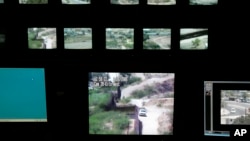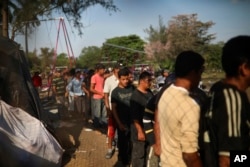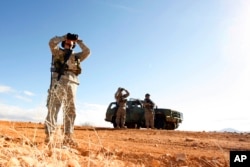While U.S. President Donald Trump has called on the National Guard to enhance security at the U.S.-Mexico border, the numbers do not show the border becoming more "dangerous" as he tweeted Sunday.
Assessing the threat at the frontier is generally done through the number of border apprehensions of undocumented immigrants by Customs and Border Patrol (CBP) agents.
At the southwest border, CBP numbers show that in 2017 about 303,916 people were detained.
"So, we were seeing the lowest numbers in a very long time. We're seeing the lowest numbers of Mexicans being detained at the border in 50 years," Andrew Selee, president of the Migration Policy Institute, told VOA.
There has been a slight increase in apprehensions since the end of 2017.
"We finally got it to the point where that number neither grows nor shrinks," Selee said. "You know, now reasonable people can have a debate about whether we need to do more, we really want to drive people out and we want to, you know, make it even harder to overstay visas or to cross the border, or we think we're doing well enough and we want to do something to bring people out of the shadows. Those are the two poles … but we've done fairly well, at least, in keeping it as a balanced number."
But Mark Krikorian, executive director of the hardline Center for Immigration Studies, says the drop is not as low as the statistics suggest. "The reason the border statistics are down is ... you often had the same people coming in over and over again," he said, and cutting down on repeat violators makes the statistics look better. But "this problem never goes away," he added.
The caravan
Trump’s tweets indicate that the impetus behind the call for the military to secure the border was a caravan of more than 1,000 migrants from Central America that set out to make a more than 4,000-kilometer journey from the Mexico-Guatemala border to the U.S. border. Pueblo Sin Fronteras, the NGO that organized the annual pilgrimage, did so to dramatize the plight of migrants.
"Our dream is to build solidarity bridges among peoples and turn down border walls imposed by greed," Pueblo Sin Fronteras writes on its website.
But Krikorian said the caravan was "intentionally designed as provocation" and that the National Guard is an appropriate response. "This caravan thing is what sparked it. … In that sense, it doesn’t matter who else is crossing the border; there has to be a firm response. Otherwise, you are advertising to people who aren’t in caravans yet that they can come in. … You have to nip this kind of thing in the bud even if the crossings are low."
Thursday, amid reports that the caravan broke up well south of the U.S. border, the president issued a victory tweet:
Others think calling up the National Guard was a solution for which there was no problem.
"They [the caravan] explicitly said they're doing this in the open, and they are going to turn themselves in to border patrol," David Bier, immigration policy analyst at the CATO Institute, told VOA. "So, there is really no need for any kind of reinforcements or the military to be deployed. It doesn't make sense, given this situation, to think that we're in any kind of crisis."
Calling in the Guard
Deploying troops is not as simple as issuing a proclamation. The National Guard is a force of reserve soldiers under the auspices of the states, meaning that governors from Arizona, New Mexico, Texas and California will have to sign off on the deployment of the force. So far, none has publicly agreed.
"I've spoken with all the governors," Department of Homeland Security Secretary Kirstjen Nielsen told Fox News on Thursday. "I will speak with them again today. … We are working on the negotiations as we speak."
The Los Angeles Times reports that the California National Guard already has about 250 people working on missions to stop illegal drugs from entering that state, including 55 along the border.
If the guard does end up being activated, it will be limited in what it can do. "The military is prevented from partaking in any kind of domestic law enforcement activities," Bier said. "When President [Barack] Obama and President [George W.] Bush deployed the National Guard for a few months in 2010 and 2006, what they actually did was dig ditches, act as watchers for the Border Patrol, or just look though and, you know, hopefully that's going to scare some unauthorized immigrants from trying to cross the border."
From 2006 to 2008, Bush deployed 6,000 National Guard personnel when the government was trying to hire more CBP agents. Obama activated 1,200 National Guard from 2010 to 2012 to strengthen border security.














